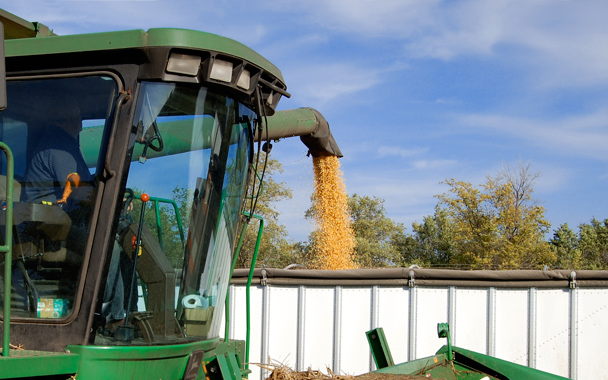Finally. Corn. Pheasant season is in Dale Hargens’ rearview mirror. Everyone left on the farm is there to work. The snow has melted from Charlie Johnson’s fields. It’s been warm and dry for four days. Jim Lutter has finished combining soybeans. Amidst otherwise miserable reports from his neighbors, Lutter harvested 43 bushels an acre. He planted late and avoided the worst of the wet spring. Could that have been the difference between his 43 bushels an acre and Charlie Johnson’s 20?
These are weeks when farmers dream of getting out of debt, or going in deeper. The corn harvest tells all. These are days when farm-belt politicians imagine that ethanol can actually be an alternative to foreign oil. These are the days when scientists expand the universe of corn-based, “value-added” products to meet the harvest.
“Value-added” is one of the great slippery ideas of modern industrial farming. Take a primary crop, like corn, and use it in a way that makes a more valuable product. Corn is made into a thousand different products, and soybeans are close behind. Dale Hargens, our optimistic prophet of industrial agriculture, promises that scientists “have just scratched the surface of what we can do with soybeans.”
Ethanol is the most recent blockbuster value-added product from corn, but there are thousands of others. Corn is added to paints and processed into packaging and plastics. Corn is the sweetener in soda pop, and dozens of indestructible junk foods. With ethanol at the pump and junk food and soda pop on the shelves, our gas station convenience stores are modern corn palaces.
Jim Lutter has a problem, and his problem takes us back to the roots of value-added agriculture on the northern Plains. Jim has a feedlot on his farm with a capacity for 2,000 animals. He wants to contract with buffalo ranchers to finish their feeder bulls on corn and sell them into a niche market. But Jim has only 200 animals in his lot. Why can’t he get going? Should he try to get in deeper, or get out?
After World War II, farmers from eastern South Dakota and Iowa would wrap up their corn harvest, hook up their cattle trailers, and head west to the sale barns of western South Dakota to buy beef calves and yearling bulls from ranches there. They would feed the animals corn all winter, and sell them as “fattened cattle” in the spring and summer. It was a great way of turning cheap corn into valuable beefsteak. It gave farmers a way to make money from winter labor. Before the emergence of giant feedlots, every farmer had a small corral complex and 100 cattle, or pigs, or chickens (often all three) chowing down on locally grown cracked corn. On the remote farms of South Dakota, it was more profitable to ship cattle than bulk grain to market. It was said in the ’50s that a farmer could put his children through college on the profits from 100 fattened cattle.
Today, beef marketing agents tell consumers that corn-fed beef tastes better. But old timers will tell you that they didn’t finish cattle on corn to improve the taste. They needed a way to roll their cheap corn into a more valuable product. On the consumer end, restaurants and markets wanted a stable, consistent, year-round product that couldn’t be grown on seasonal, widely different free-range grasses. They didn’t want local nuance.
Today’s 100,000-unit feedlots are the end result of the value-added logic, with the strange, counterintuitive twist that an animal that has been force-fed commodity grain, standing in its own waste, sick from the stress of over-crowding and disease will end up tasting better than an animal raised its whole life on grass. Which brings us back to Jim Lutter.
Jim would love to raise his buffalo on native grass pastures. In the worst winter blizzards, he could feed the herd bales of his intermediate wheatgrass, maybe even a little distillers dry grain, the protein-dense byproduct from the local ethanol plant. He would love to “let buffalo be buffalo.” But the market for buffalo is chasing beef, right into a feedlot. There is no demand for grass-fed buffalo. “Our main clients are restaurants,” says Bruce Anderson, owner of Western Buffalo Company, in Rapid City, and one of the largest buffalo processors in the country. “Restaurants want consistency. I have to give them a steak that is the same size and the same taste every day of the year. I can’t get that off grass.”
So Jim Lutter is stuck between the proverbial rock and hard place. He can’t make any money raising buffalo on grass pasture, and if he puts the buffalo in his feedlot, he has to compete with ethanol plants and industrial processors for expensive corn. Quietly Lutter wonders to himself: If we put buffalo into feedlots and pump them full of corn, have we really added value, or just turned the symbol of American wildlife into a shaggy brown cow? Where’s the profit in that?




 Pinterest
Pinterest


